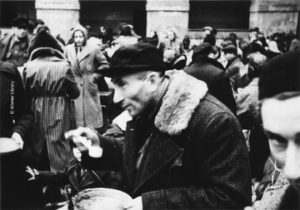23 June 1944: The Red Cross visits Terezin concentration camp
On 23 June 1944 the International Red Cross sent a delegation to inspect Theresienstadt Concentration Camp (often referred to as Terezin). The Nazis made temporary improvements to the camp to give the visitors a positive impression, and continued with deportations soon afterwards.

Terezin concentration camp © The Wiener Holocaust Library
The inspection was demanded by the King of Denmark, following the deportation of 466 Danish Jews to Terezin in 1943.
Theresienstadt was a ghetto and concentration camp 30 miles north of Prague. It was operational from 24 November 1941 to 9 May 1945. More than 150,000 Jews were detained there during this time. Around 33,000 people were murdered in Theresienstadt, and roughly 88,000 were sent from there to death camps in German-occupied Poland.
In preparation for the inspection, the Nazis deported 7,503 Jewish people to Auschwitz between 16 – 18 May 1944, to make the ghetto appear less overcrowded. They arranged for flowers and grass to be planted, gave the prisoners new clothes and made a show of providing good food for them. Fake shops, schools and cafes were built, and cultural performances were put on for the delegation.
The inspection went smoothly, with the Red Cross being taken on a specified route and only talking to prisoners who looked well and who had been briefed beforehand. They seemed to form a positive impression of the camp, so the ruse was successful.
After the Red Cross inspection, the Nazis produced a propaganda film that aimed to show people being treated well under the protection of the Third Reich. After filming, the Nazis returned the camp to its usual state and continued deportations, including those who appear in the film.
While estimates of children imprisoned in Terezin vary, it is thought that out of around 15,000 children only approximately 10% survived. After the war, a collection of art and poetry, written by children, was found hidden in the camp.


